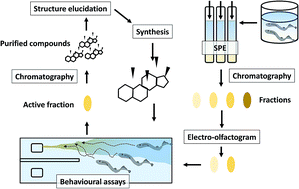Discovery and characterization of natural products that act as pheromones in fish
Abstract
Covering: up to 2018
Fish use a diverse collection of molecules to communicate with conspecifics. Since Karlson and Lüscher termed these molecules ‘pheromones’, chemists and biologists have joined efforts to characterize their structures and functions. In particular, the understanding of insect pheromones developed at a rapid pace, set, in part, by the use of bioassay-guided fractionation and natural product chemistry. Research on vertebrate pheromones, however, has progressed more slowly. Initially, biologists characterized fish pheromones by screening commercially available compounds suspected to act as pheromones based upon their physiological function. Such biology-driven screening has proven a productive approach to studying pheromones in fish. However, the many functions of fish pheromones and diverse metabolites that fish release make predicting pheromone identity difficult and necessitate approaches led by chemistry. Indeed, the few cases in which pheromone identification was led by natural product chemistry indicated novel or otherwise unpredicted compounds act as pheromones. Here, we provide a brief review of the approaches to identifying pheromones, placing particular emphasis on the promise of using natural product chemistry together with assays of biological activity. Several case studies illustrate bioassay-guided fractionation as an approach to pheromone identification in fish and the unexpected diversity of pheromone structures discovered by natural product chemistry. With recent advances in natural product chemistry, bioassay-guided fractionation is likely to unveil an even broader collection of pheromone structures and enable research that spans across disciplines.



 Please wait while we load your content...
Please wait while we load your content...